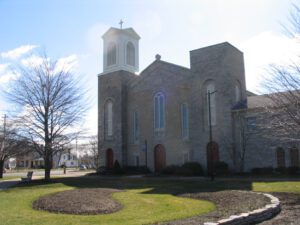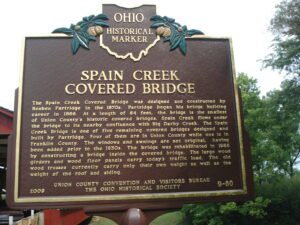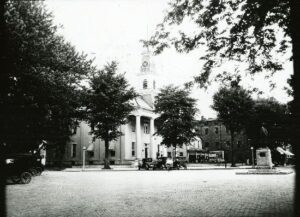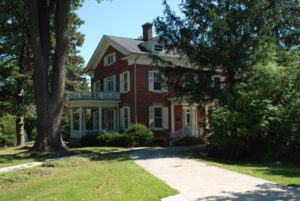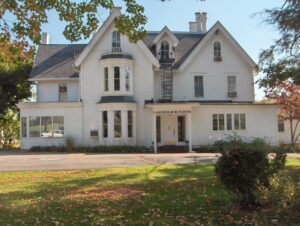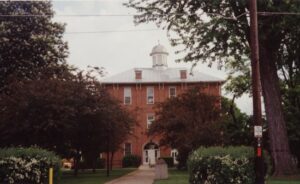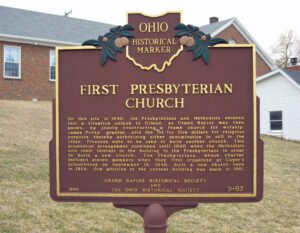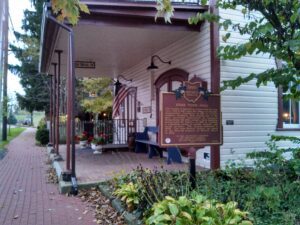, OH
This building was begun in 1835 and was completed in 1844. It is the oldest church building in continual use in Sandusky and incorporates a portion of the original structure. This marker commemorated the one hundred fiftieth anniversary of the laying of the cornerstone and the church’s sesquicentennial observance in 1985.
, OH
The Spain Creek Covered Bridge was designed and constructed by Reuben Partridge in the 1870s. Partridge began his bridge building career in 1866. At a length of 64 feet, the bridge is the smallest of Union County’s historic covered bridges. Spain Creek flows under the bridge to its nearby confluence with Big Darby Creek. The Spain Creek Bridge is one of five remaining covered bridges designed and built by Partridge. Four of them are in Union County while one is in Franklin County. The windows and awnings are not original, having been added prior to the 1930s. The bridge was rehabilitated in 1988 by constructing a bridge inside the covered bridge. The large wood girders and wood floor panels carry today’s traffic load. The old wood trusses currently carry only their own weight as well as the weight of the roof and siding.
, OH
Morgan County was created in 1817 from parts of Washington, Muskingum, and Guernsey counties, with McConnelsville established as the seat of government. The first courthouse, a square brick structure, was built here in 1820. Its foundation stones form part of the wall surrounding the lawn. The present courthouse building was completed in 1858 at a cost of $10,000. This Greek Revival-style structure has had several major renovations since. The clock tower was added in 1886, and the building was enlarged and modernized in 1960.
, OH
Jabez Lyman Burrell (1806-1900), originally from Massachusetts, built this house in 1852. Burrell made his living as a cattleman and farmer, but devoted much of his time serving the cause of abolitionism, helping slaves, who had escaped the South, get to Sheffield and from there to Lorain and across Lake Erie to Canada. He was also devoted to equal education for all, providing funding to a freedmen’s school in Selma, Alabama, and serving as a trustee of the Oberlin Collegiate Institute, well known for educating African Americans and women. From 1884 to 1934, this was the home of Henry Churchill King (1858-1934), who was the president of Oberlin College from 1902-1927. The Kings added the porches and rear wing and made their home a social center for the college and community. The house is listed on the National Register of Historic Places and is a City of Oberlin Historic Landmark.
, OH
Lakeholm was built as the home of Columbus Delano while serving as Secretary of the Interior under President Ulysses S. Grant from 1870 to 1875. Delano (1809-1896) came to Mount Vernon in 1817, attended public schools, studied law, and was admitted to the bar in 1831. In addition to practicing law in Mount Vernon and serving as the Prosecuting Attorney of Knox County, Delano was a farmer, mill owner, and politician. Lakeholm, originally part of a 300-acre farm, contains many of its original rooms and Italianate features. In 1966, 209 acres of the farm were acquired for the establishment of the Mount Vernon Nazarene College. The house served as offices, meeting rooms, and classrooms. In 2002, the college became a university and continues to use Lakeholm for administrative offices. Historic Lakeholm is a focal point on the Mount Vernon Nazarene University campus and a symbol of the institution’s ties with the Mount Vernon community.
, OH
When Sunbury was platted in 1816, a town square was set aside for public use with the intention of constructing a town hall on the site. The first two stories of the Town Hall were built, as a school, in 1868 for $5,000. The Masons added the third story for $1,500 and occupied it for 91 years, until a lodge was constructed. Since 1868, the Town Hall has served Sunbury as a village office building, jail, fire station, and community library. Church services as well as Farmer’s Institutes were held in the building, and at one time it housed a bank. In 2002, the Town Hall was renovated for use as a community room and village offices.
, OH
On this site in 1848, the Presbyterians and Methodists entered into a situation unique to Gilean, as Grand Rapids was then known, by jointly constructing a frame church for worship. James Purdy, grantor, sold the lot for five dollars for religious purposes thereby authorizing either denomination to sell to the other. Proceeds were to be used to build another church. This ecumenical arrangement continued until 1880 when the Methodists sold their interest in the building to the Presbyterians in order to build a new church. The Presbyterians, whose charter included eleven members when they first organized at Guyer’s schoolhouse on September 18, 1848, built a new church here in 1928. One addition to the current building was made in 1961.
, OH
The Society of Separatists of Zoar built the Zoar Town Hall in 1887 when the village was formally incorporated. Established in 1817 by German religious dissidents, Zoar became one of the most successful experiments in communal living during the 19th century. Early hardships encouraged the Zoarites, in 1819, to establish a communal system to ensure economic and social security. The Society disbanded in 1898. The Zoar Historic District was added to the National Register of Historic Places in 1969.


